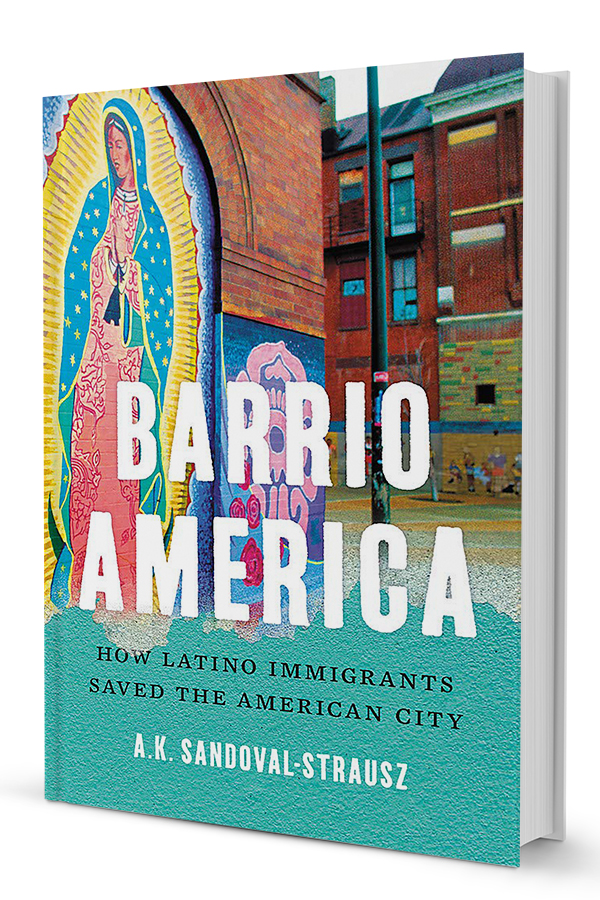
In his new book Barrio America: How Latino Immigrants Saved the American City, A.K. Sandoval-Strausz challenges the narrative that the white professionals who began returning to cities in the 1990s and 2000s are responsible for the modern urban renaissance. Instead, he credits immigrants from Latin America who arrived in the 1970s, a low point for urban America, when cities were desperately in need of repopulation. Sandoval-Strausz’s book looks closely at how Latinos rescued two neighborhoods: Oak Cliff in Dallas and Little Village in Chicago, which he got to know when he was a graduate student at the University of Chicago from 1994 to 2001. Sandoval-Strausz is currently an associate professor of history at Penn State University.
Why was it so important that Latinos and Latino immigrants began emigrating to cities in the 1970s, and how did that set the stage for where we are today?
Roughly 1970 might have been close to the very bottom of the urban crisis, because it was right after the series of urban riots in places like Newark and Detroit. Many people saw those as a signal that the slow decline of the American city [happening] since about 1950 had picked up speed, and it was time to go. There were a lot of shopkeepers and business owners who said, “That’s really the last straw.”
You see the departure of American-born people, especially white people, accelerating at that point. There were a lot of urban specialists who said, “It may be that the era of the big American city has come and gone.” In Chicago, the Tribune ran an article [series] a few years later called “City on the Brink” which said, “Things may never get better here.” That was when the city most needed a new infusion of residents, of consumers, of workers. That’s exactly what the newcomers were.
Why did you choose Little Village as one of the two main neighborhoods you study in this book?
There are two reasons. One is, I went to graduate school at the University of Chicago and I was really familiar with it. Probably the better reason is that Chicago is the number-one urban history and urban studies city in the United States. It’s where the Chicago school of sociology was born, it’s where just a huge number of very influential studies have been done, everything from Heat Wave [by Eric Klinenberg, second edition published 2015] to Great American City [by Robert J. Sampson, published 2011]. It’s just a perfect laboratory to look at things. It’s also the second-biggest center of Mexican population in the United States, after Los Angeles. There’s a diaspora of more than a million ethnic Mexicans, and of course there are large numbers of Puerto Ricans, Central Americans and others, so it really is a big center of Latino culture.
Who is Richard Dolejs, why is he important to this story, and how and why did he rename the neighborhood from South Lawndale to Little Village?
Richard Dolejs was a real estate agent and president of the chamber of commerce in the neighborhood, which at the time was called South Lawndale. South Lawndale had started losing population as early as 1920. The 1924 National Origins Act slashed immigration from Central and Eastern Europe, and that’s where a lot of immigrants to the neighborhood had come from. It was a very strongly Polish and Bohemian neighborhood. It was also the scene of very gradual deindustrialization. The housing there was fairly old and crowded.
Dolejs sees that his neighborhood was shrinking even faster than before, because a lot of Chicagoans did not want to have any black neighbors, and they would even resort to violence to keep them out. He thought that a better approach was to take a positive angle to it. So first, he thought, “Let’s rename South Lawndale to Little Village,” to refer to its Central European origins, and also — this was the discriminatory part — make sure people don’t confuse it with North Lawndale, which was a neighborhood that had gone from overwhelmingly white to overwhelmingly black in about ten years. He decides to pursue Mexican Americans and Mexican nationals as new neighbors. He didn’t think his fellow residents of Little Village were going to accept black people as neighbors. This was directed at figuring out who might come in to revitalize and repopulate the neighborhood, but he ruled black people out.

How did the ethnic composition of Little Village change, from 1960 until today?
In 1960, it’s 2 percent Hispanic in 1970, it’s 33 percent Hispanic. So the overall number of people in the neighborhood does not change between 1960 and 1970, but a lot of non-Hispanic whites move out [and] a lot of Latinos move in. Then after that, by the 1990s, it’s about 85 percent Mexican American and 11 or 12 percent African American.
What would Little Village look like if Mexicans hadn’t moved in?
We can start with the example of North Lawndale. North Lawndale lost much of its African American population because after 1968, they have better opportunity to buy houses in the suburbs. The [Fair] Housing Act criminalizes discrimination, but in the meantime, because so many people were moving out of North Lawndale, a lot of the property owners could not rent or sell their houses. So, a lot of them just deliberately burned the houses down for the insurance money. In that one community area, from 1950 to 1980, 10,000 units of housing were lost, some to arson, some to abandonment and neglect. In South Lawndale, there was no loss of housing units — exactly the same number for decade after decade. There were thousands upon thousands of houses that would have ended up burned out, destroyed, or collapsed, had these new residents not shown up. If 25 million Latinos and Latinas had not come to American cities, you’d see a lot more parts of Chicago that look like Detroit or Gary or Youngstown, Ohio: empty schools, shuttered factories, office buildings, and railroad stations that are like ghost towns.
Another part of your argument is that we shouldn’t give all the credit to the return of white professionals for the rebirth of cities.
There are two reasons for that. Number one is Latino immigrants began to come to neighborhoods three or more decades before that back-to-the-city, creative-class phenomenon. I think the other thing to remember is that yuppies and the creative class could not return to the city without a lot of the labor, goods, and services provided by immigrants, especially Latinos: home construction, home renovation, child care, building maintenance, and food services, from food-picking and meatpacking to cooking, serving, and cleaning up. Without Latinos, that work just does not get done.



